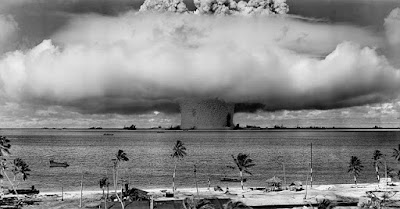Uranium is a metal used in atomic weapons and nuclear power plants because it is a radioactive element. The atoms of a radioactive element disintegrate over time, losing particles from its nucleus and releasing significant amounts of energy.
Normally, this process occurs in some uranium atoms at once. But in an atomic bomb, the atoms split up quickly, releasing large amounts of energy instantly.
Uranium atoms disintegrate inside an atomic bomb because they are hit by subatomic particles or neutrons. When a neutron hits the nucleus of a uranium atom, it causes the nucleus to split.
This produces energy and sends the particles of the uranium atom that crash into other atoms, whose nuclei disintegrate at the same time, sending more energy and particles, and so on. This process is called a chain reaction.
Once the chain reaction starts inside the bomb, the process continues until most of the atoms have split. This happens in a fraction of a second, so all the uranium energy is released.
.
Showing posts with label weapons. Show all posts
Showing posts with label weapons. Show all posts
Is a fission bomb the same as a hydrogen bomb?
The A-bomb equals an H-bomb?
Not at all. The natural process that triggered the first atomic bombs is contrary to the process used by the hydrogen bomb, or H-bomb.
In a conventional atomic bomb or A-bomb, energy is produced from uranium atoms. This releases some of the energy that held the atoms together. The process is called fission, which means 'split apart'.
In hydrogen bombs, on the other hand, there is another process called fusion. In a hydrogen bomb, the enormous amounts of heat cause hydrogen atoms to join together, forming helium atoms. When hydrogen atoms melt, some of their mass is changed into energy. This is the energy released by the H-bomb.
The only way scientists have found to create the necessary heat required by the fusion process in an H-bomb is to first detonate a fission bomb. So, an atomic fission bomb acts as the detonator of the even more powerful H-bomb.
The atomic bomb explodes first, producing enough heat to power the hydrogen bomb.
The bombs dropped in Japan during World War II were atomic fission bombs, but their power was minuscule compared to the nuclear bombs that exist today.
.
Where does the boomerang come from?
For the past ten thousand years, Aborigines in Australia have used a type of weapon called bumerangs to kill the animals and birds they feed on. These weapons are designed to fly in a straight line to the victim, deliver a lethal blow and fall to the ground. The boomerangs that return to the thrower are smaller and lighter, and aborigines do not use them for hunting but only for recreational purposes.
In 1981, the official boomerang launch mark was established in Albury, New South Wales, in the Australian specialty championship: Bob Burwell, a telecommunications engineer, got a boomerang to fly 111 meters before it made the turn back.
For a boomerang to return it is not essential that it has its characteristic arched shape, since there are those with the shape of T, V, X and Y that are also capable of returning with the launcher. For the boomerang to be effective it is enough to splice two pieces of wood in the correct angle with an elastic league.
The shape of boomerang depends on of the wood they're made of. Those who return to the hand of the throwers can measure up to 75 cm and weigh almost 250 grams, and the hunting ones are usually more big and heavy. Boomerangs are sometimes decorated with red, white and yellow pigments.
.
In 1981, the official boomerang launch mark was established in Albury, New South Wales, in the Australian specialty championship: Bob Burwell, a telecommunications engineer, got a boomerang to fly 111 meters before it made the turn back.
For a boomerang to return it is not essential that it has its characteristic arched shape, since there are those with the shape of T, V, X and Y that are also capable of returning with the launcher. For the boomerang to be effective it is enough to splice two pieces of wood in the correct angle with an elastic league.
The shape of boomerang depends on of the wood they're made of. Those who return to the hand of the throwers can measure up to 75 cm and weigh almost 250 grams, and the hunting ones are usually more big and heavy. Boomerangs are sometimes decorated with red, white and yellow pigments.
.
Subscribe to:
Posts (Atom)


